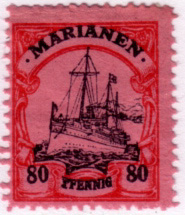

Return To Catalogue - Germany - German colonies
Note: on my website many of the
pictures can not be seen! They are of course present in the cd's;
contact me if you want to purchase them: evert@klaseboer.com.
The following forgeries are of the small ship design, I never saw Fournier forgeries of the larger sized stamps (1 M to 5 M).



Fournier forgeries

A genuine stamp for comparison
The perforation doesn't 'match' in the corners.


The above stamps are Fournier forgeries, however, they are not listed in the Fournier pricelist of 1914. These imperforated stamps are probably taken from a 'Fournier Album'. After Fournier died, albums with his forgeries were sold to warn collectors against these forgeries. These stamps were of course sold by Fournier with perforation and without the 'FAUX' (=forgery in french) overprint. Note that the 'S' of 'KIAUTSCHOU' is strange in the above two stamps and that the word 'KIAUTSCHOU' is too curved too fit exactly in the label.
Fournier seems to have printed these forgeries in sheets containing one value of each colony, examples of (unfinished) sheets:


In the top row were printed: 'Deutsch
Südwestafrika, Kiautschou, (pfennig value), Deutsch-Neu-Guinea
and Kiautschou (cents value). In the middle row Kamerun,
Marianen, Samoa and Deutsch-Ostafika (value in pesa). Finally in
the bottom row Karolinen, Marshall-Inseln, Togo and
Deutsch-Ostafrika (value in heller). I have also seen similar
sheets for the values: 3 p (or the corresponding value in cents
of Kiautschau, in pesa or heller for German East Africa), 10 p,
20 p, 25 p (with blanks for the unissued cents value of
Kiautschau and the pesa value of German East Africa), 40 p, 50 p
(with blanks for cents value of Kiautschau and the heller value
of German East Africa) and 80 p.
I have also seen a similar sheet with 12 stamps of the 45 h value
of German East Africa. I presume this sheet was also produced by
Fournier.
In the 1970 photo-lithographed stamps appeared in the USA, purporting to be stamps of the German colonies. The stamps can be easily recognised by their general dull and flat appearance. The colours are weak and the shading is often solid colour. The paper is unwatermarked and somewhat coarse. It is less stiff than that of original stamps. The forged stamps are perforated 13 (genuine stamps have perforation 14). Most of these forgeries are uncancelled, but some bear falsified postmarks as well (information Dirk Spennemann). Probably all small ship stamps of all colonies were forged. Examples of these forgeries:



(Images obtained thanks to Dirk Spennemann)
I think the above forgeries are also USA forgeries, they have a very strange cancel: 'KETE KRATS.....'. I have also seen the values 10 p red and 20 p blue of Togo with exactly the same cancel.

(Forged bisected stamp)

Fournier forgery of the 15 h ship type of German East Africa
(left) and another bogus product which is much larger in size.


Two forgeries, possibly of Italian origins (Oneglia?).
The provisional overprints of the German Colonies by Great Britain have been extensively forged.

(Forged overprint)
From late 1999 onwards genuine stamps and forged overprints imposed on genuine stamps were offered on the on-line auction-house e-bay by the Florida-based seller cclan. Since then large numbers of additional overprints covering wide aspects of philatelic collection fields have been offered by 'cclan' and later by sellers calling themselves 'adtinvest,' 'futete,' and 'unlimitedstamps'. All are/were based in Hialeah in Florida (USA). By late 2000 these sellers also offered stamps on Yahoo Auctions. Beginning in May 2000 a large number of forged G.R.I. overprints of German colonial stamps from Samoa, the Marshall Islands and German New Guinea were offered for sale on the on-line auction house e-bay (information Dirk Spennemann). I've seen inverted and double overprints. The forgers also invented fake forger names to sell there merchandise. I have the impression that the seller atdinvest is printing its own stamps recently (normally in imperforate sheets with fancy overprints of too many countries to name here). For more information on Hialeah forgeries click here. Much more on these forgeries can be found on http://marshall.csu.edu.au/html/Stamps/Stamps.html, made by Dirk H.R. Spennemann. Some examples:


(Genuine and forgery of a Samoa overprint)
The ink seems to leak through the paper in these forgeries, modern ink is used:


According to Dirk Spennemann: "Because hand-held rubber stamps were used to produce these forgeries, the overprint is fuzzy, and broad, as opposed to crisp and clear. On the original genuine overprints the letters were set in formes, with both rows of characters set parallel. As the production of the Hialeah overprints was done manually, most lcertainly using seperate rubber stamps for the 'G.R.I.' and the value, this parallel alignment is not maintained." The cancelling dates should also be checked as sometimes impossible dates are used on these forgeries.
All overprinted Samoa stamps with watermark are forgeries!

(Some Hialeah forgeries, reduced sizes)
I have recently (August 2003) seen some large ship stamps of the German colonies (with and without 'GRI' overprint) made by the Hialeah forger. I have also seen some of the smaller ship values forged by the Hialeah forger. The perforation is very bad and the printing not very clear.
I've seen an unofficial imperforate minisheet with red ship stamps (2 rows of 5 stamps, German East Africa, Cameroons, Togo, Samoa, Kiautschou, German South West Africa, Carolines, Marshall Islands, Marianas and German New Guinea), which was issued in 1963 for the 40th anniversary of the 'Arbeitsgemeinschaft der Sammler Deutscher Kolonialpostwertzeichen'. At least 1900 sheets were issued (I've seen sheet 1896). An oblique overprint '50 JAHRE 1923-1973' was apparently applied on this sheetlet 10 years later.